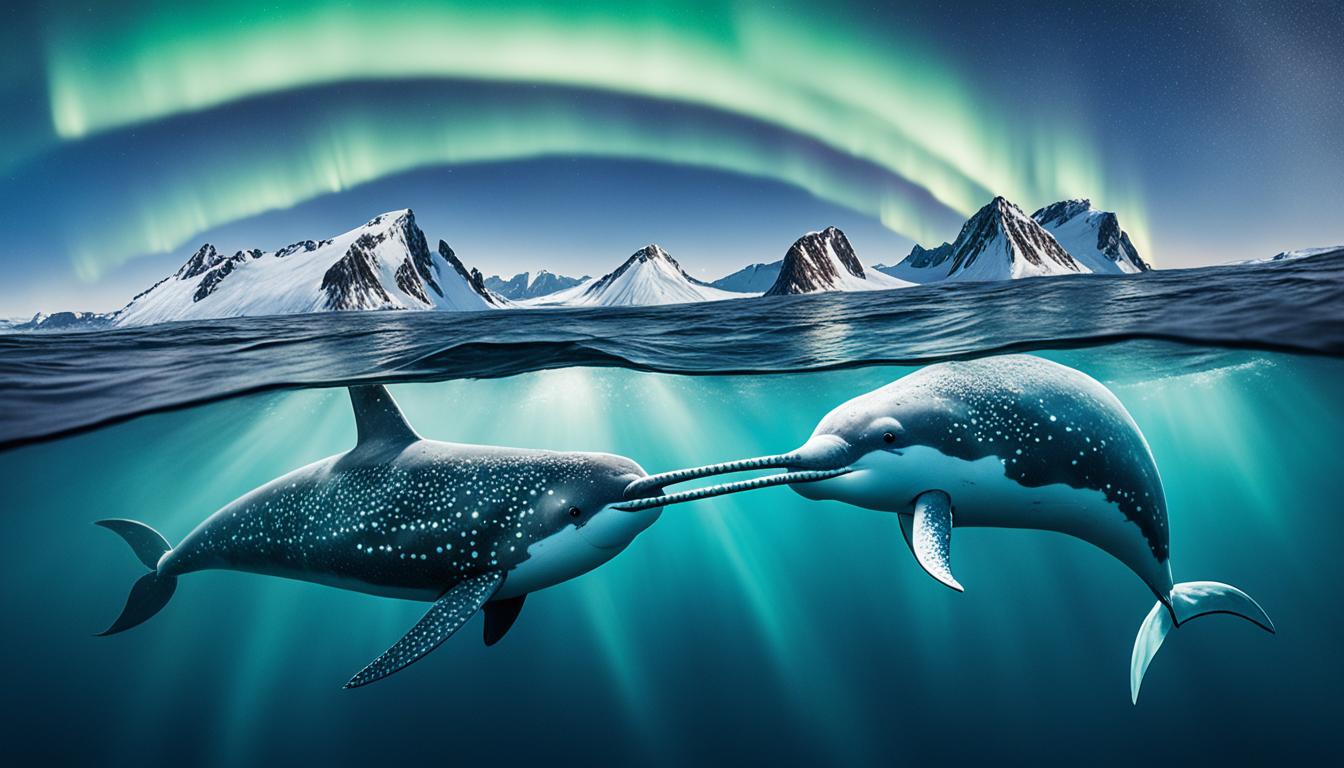Narwhals, known as Monodon monoceros, live mainly in the Arctic waters around Canada, Greenland, Norway, and Russia. It’s crucial to understand how they reproduce to help protect these fascinating creatures. Their unique tusks and secretive nature make you curious about their breeding habits. Let’s dive into their mating and breeding to learn more about their challenges in the wild.
Narwhal Reproduction Process
The way narwhals reproduce is quite interesting. They do this mainly during mating season, from late winter to early spring, around March and April. This happens mostly in the ocean, about 200 miles away from the coast.
Females become ready to have babies between ages 8 and 9. Males take a bit longer, usually between 12 and 17 years old. This age difference affects how narwhals mate.
Narwhals have complex social behaviors during mating. Male narwhals show off their long tusks to prove dominance and attract mates. These tusks are key to understanding their social lives.
To sum up, narwhals’ reproduction is shaped by their unique behaviors and growth. Learning about this helps us understand how they survive in the harsh Arctic.
Mating Behavior of Narwhals
Narwhals have fascinating mating habits that involve complex social interactions. In the summer, they gather in Arctic bays and fjords. Males show off by crossing their long tusks. This can be seen as both a way to court females and to show who’s in charge.
Narwhals don’t make mating songs like some other sea creatures. This leaves us wondering about the role of sound in their mating. Scientists are still looking into how important sight and touch are in their mating rituals.
Male narwhals compete with each other during mating. The length and health of their tusks matter a lot. Longer tusks might mean a male is more likely to win in the mating game. This affects their social order and who leads the group.
How do narwhals reproduce?
Narwhals have a unique way of reproducing. They go through a journey to become sexually mature and have a special mating season.
Sexual Maturity
Narwhals become sexually mature at different times. Female narwhals are ready between 6 to 9 years old. Males take a bit longer, reaching maturity between 8 to 17 years old. This difference affects their mating and social life.
Mating Season
The mating season for narwhals happens in the spring, mainly in March and April. This matches their migration to colder waters. Mating leads to successful reproduction, followed by a 14 to 15-month pregnancy. Babies are born in the summer, from late May to June.
| Parameter | Females | Males |
|---|---|---|
| Age of Sexual Maturity | 6 to 9 years | 8 to 17 years |
| Mating Season | March to April | March to April |
| Gestation Period | 14 to 15 months | N/A |
| Calving Months | Late May to June | N/A |
Narwhal Breeding Habits
Narwhals have special breeding habits shaped by their Arctic home and the seasons. They have a unique way of reproducing that fits their icy environment. Female narwhals get pregnant about every three years, which matches their breeding cycle. This helps them raise their young in the safest places.
Female narwhals usually give birth in deep bays and inlets to keep their babies safe from bad weather. These spots offer a secure place for the young ones, who rely on their mothers for up to 20 months. This close bond is crucial for the calf’s survival and learning important ocean skills.
The narwhals breed near areas with ice, which helps protect the young. Males and females mate close to these icy spots. This makes sure the breeding happens in the best conditions for successful births and raising the young.
| Aspect | Description |
|---|---|
| Calving Interval | Every 3 years |
| Calf Dependency | Up to 20 months |
| Preferred Birth Locations | Deep bays and inlets |
| Mating Location | Near ice-covered habitats |
Learning about narwhal breeding habits shows how they’ve adapted to their Arctic home. These behaviors help the calves survive and show how important the environment is for their success.
Reproductive Cycle of Narwhals
The reproductive cycle of narwhals is key to their survival. It includes the gestation period and the time between births. These phases help us understand how narwhals care for their young.
Gestation Period
The gestation period for narwhals is about 14 to 15 months. This long time lets the calf grow well in the womb. When born, a calf is around 1.5 meters long and weighs 180 pounds.
This size and weight help the calf survive in the Arctic. It’s well-fed and ready for the cold.
Calving Interval
Narwhals give birth every three years. This lets the mother recover and care for her calf. It’s crucial for the calf’s early survival.
Calves are born during the summer migration. This move helps them find a safer place to grow.
| Phase | Duration | Details |
|---|---|---|
| Gestation Period | 14-15 months | Calf born approximately 1.5 meters long and 180 lbs |
| Calving Interval | Every 3 years | Allows recovery and calf nurturing |
Factors Affecting Narwhal Reproduction
Narwhals’ reproduction is shaped by both environmental and biological factors. Their big migrations, linked to ice formation, are key to their mating and breeding success. Things like sea ice thickness, water temperature, and prey availability affect female health and calf survival. Knowing these factors is key for saving narwhals.
Humans also add challenges. Hunting, harming their homes, and climate change threaten narwhals. These issues affect narwhals’ reproductive health and their population’s overall health.

Narwhal Reproductive Biology
Narwhal reproductive biology is quite fascinating. It includes unique traits that help these animals mate in special ways. The male narwhal’s long tusk, up to ten feet long, is a key feature. This tusk shows the male’s health and genetic strength. It helps females choose their mates during mating seasons.
The tusk is not just for mating. It also helps males show strength and dominance in social settings. This can affect how successful they are in finding mates. Narwhals live in groups, so knowing their social structure helps us understand their mating habits.
Scientists are studying narwhal reproductive biology to learn more. These studies are important for understanding mating habits and for protecting their homes. They show how social behaviors, migration, and mating methods make narwhals’ lives interesting. We need to keep exploring to learn more about these marine mammals.
FAQ
How do narwhals reproduce?
Narwhals reproduce during the mating season, which peaks in late winter to early spring. Mating happens in their wintering grounds offshore. Females give birth after about 14 to 15 months of pregnancy.
What are the mating behaviors of narwhals?
Narwhals show complex social behaviors during mating. Males may cross their tusks and make sounds. These behaviors are seen in Arctic bays and fjords during summer.
What factors influence narwhal reproduction?
Narwhal reproduction is affected by sea ice thickness, water temperature, and prey availability. Human activities like hunting and climate change also threaten their reproduction.
At what age do narwhals reach sexual maturity?
Female narwhals become sexually mature between 6 to 9 years old. Males mature between 8 to 17 years old. This age difference affects their reproductive cycles.
When is the narwhal mating season?
Narwhals mate mainly in March and April. This matches their migration patterns, which affects their breeding habits and success.
What is the gestation period for narwhals?
Narwhals are pregnant for about 14 to 15 months. After that, females give birth to one calf in late May to June during the summer.
How often do narwhals give birth?
Narwhals have a calving interval of about three years. This allows females to recover and ensures their calves’ survival.
What is the role of the narwhal’s tusk in reproduction?
The narwhal’s tusk shows a male’s health and genetic quality. It’s key in male competition and mating success.
Why is understanding narwhal reproductive biology important?
Knowing about narwhal reproduction helps in conservation. It guides efforts to protect them from environmental and human threats.







